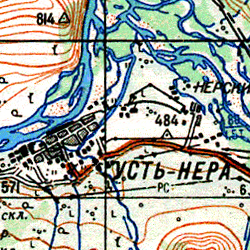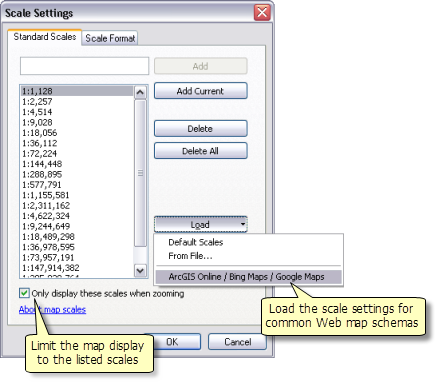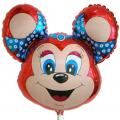Topographic materials include: plan, map and profile. Topographic plan called a reduced and similar image on paper of horizontal projections of terrain areas. As shown above, a similar image is obtained by orthogonal projection of sections earth surface not exceeding 20 × 20 km per horizontal plane. In a reduced form on paper, such an image is called a plan of the area.
Maps get really interesting when we start adding people data to them - population, economic production, social behavior, etc. collation is a powerful way to summarize and communicate this kind of data. Unfortunately, juxtaposition is also a great way to confuse them.
Presented with the same data in a table or table, we can take the initiative to analyze it - in fact, we would have to analyze the raw data to figure it out. But because the impact of the visual map is so immediate and powerful, we rarely ask about it. One possible explanation is how the brain processes information: visual processing occurs on the right side of the brain, while analysis with words and numbers occurs on the left. Another thing is that the cards just look complete and do not require analysis - they can be chewed beforehand.
An image of large areas of the earth's surface (more than 20 × 20 km) on a plane cannot be obtained without distortion, i.e., with full similarity being preserved. Such areas are orthogonally projected onto the surface of the reference ellipsoid, and then from the surface of the ellipsoid, according to certain mathematical laws, called cartographic projections, they are transferred to the plane. The image obtained in this way, reduced on paper, of significant areas of the earth's surface (more than 20 km), taking into account the curvature of the earth, is called a map. The map compiled in the Gauss-Kruger projection is called topographic map.
Whatever the explanation, cards can easily deceive. An easy way to see the problems that could arise is to compare the number of crimes committed in each state. Looking at this map, we think that California, Texas, Florida and New York were terribly dangerous places to live, and that hardly any crime was ever committed in New Mexico. The problem is that we are mainly looking at the population map. Of course, the more people live in the area, the more crimes will be committed there.
For comparison. This map shows the state crime rate. A distinctly regional pattern is now emerging: crime rates are at their lowest in the northeast. It's a data mapping, but it shows the importance of choosing the right data to match - and asking when the map is presented to us if the data behind it was selected correctly.
On topographic plans and maps they show the situation and the terrain. Situation is called a set of contours and objects of the terrain. The situation is a planned part of the terrain (forest, meadow, arable land, hydrography, buildings, roads, water lines, hydraulic facilities, etc.). It is depicted on plans and maps with conventional topographic signs.
It is always worth noting the colors used on the card. You will react to these colors aside, whether you want to or not! Once you know what colors are and what they imply, you can fire them if necessary. Another way of displaying maps can distort the data by choosing the wrong scale. This is a common convention and easy to read. The question is, how much darker is the shade? It is important to read the key, and it is important to constantly tell students to read the key, because that is where the answers are.
And here, however, the map can create a powerful visual impression that we may have to work hard to fix. When compiling my crime map, I had a choice of scales. It is usually best to choose a linear scale because log scales are confusing for most people. For example, the Richter scale, which measures the intensity of earthquakes, is a logarithmic scale, so 6 on the Richter scale means that an earthquake is 10 times larger than one dimension of 5, etc. logarithmic scales are great for distinguishing between very small things and between very large things.
Relief is called a set of irregularities on the earth's surface. Relief - the high-altitude part of the area. It is depicted on maps and plans in the form of contour lines - smooth curved lines passing through points with equal heights (marks).
The main requirements for topographic maps and plans are accuracy and clarity.
Richter 3 is invisible, and Richter 9 - only six steps up in scale, but a million times more powerful - will destroy the city. But logarithmic scales are not as intuitive as linear ones. How much more powerful was the earthquake in Chile? A footnote for the answer. Since the crime rate in different states fell in a rather narrow range, I only needed six shades of red for the linear scale. Figure 15 - Scale in Figure 14.
Libra is rarely chosen with the intent to confuse; in fact, the cartographer often has little practical choice. But they can nevertheless cause confusion if the reader does not pay close attention. Problems arise quickly when you link maps at different scales.
Accuracy is understood as the correspondence of the location, shape and size of objects on plans and maps of reality. The planes are characterized by visual perception of the image of the earth's surface, its characteristic features and features.
The main characteristics of the accuracy of plans and maps are scale, and clarity - conventional topographic signs and color design. In addition to plans and maps, topographic materials include terrain profiles, which are a reduced on paper image of a vertical section of the Earth's surface in a given direction. Terrain profiles are the topographic basis for the preparation of project documentation required for the construction of railways and highways, water supply and sewerage lines and other communications.
Of course, we know that Barack Obama won the election. S. is much more conservative than it is. If we didn’t already know what it meant, it’s not true, how would we figure it out? If it is difficult for Americans to spot errors on a map of the United States, how much more difficult is it when we are presented with a map of another country? Suppose you were presented with a map of election results from Norway or economic production in China? Can you interpret this?
Projection: Albert's Equal Zone standard parallels 18º south and 32º south. Note: other maps are available. South Africa responsible for publishing and maintaining 16 sheets of this worldwide graphic series, covering southern part Africa. This series has accurate but generalized basemaps with only the most important topographic details to enable overprinted aeronautical information to be clearly identified. Each sheet covers an area of 4 degrees in latitude and 6 degrees in longitude, with an overlap to the north and east of 15 minutes.
3.3 Scope of plans and maps. Scale accuracy
When depicting areas of the earth's surface on a plan or map, the sizes of these areas are reduced by a known number of times. The degree of reduction of lines on the plan in relation to their horizontal distances (projections) on the ground is called scale.
Scales can be numerical, linear, and transverse. The numerical scale is called an expression in the form of a fraction, the numerator, which is a unit, and the denominator is a number that shows how many times the lines on the plan are reduced in relation to their horizontal projections on the ground. For example, the expression 1: 2000 shows that 1 cm on the plan contains 2000 cm (20 meters) of terrain. Knowing the numerical scale of the plan, it is possible to determine the corresponding length of the line on the plan by the length of the terrain line and vice versa. For example, if the length of the line on the plan is 3.23 cm, and the scale of the plan is 1: 2000, then the corresponding line on the ground will be
International organization civil aviation prescribes the rules and regulations for aeronautical information shown on these charts, such as aids to navigation, air routes, etc. Aeronautical chart prepared in accordance with the requirements The International Organization civil aviation. This series consists of 23 map sheets, each usually covering an area of 2º latitude and 4º longitude. This map is used for route planning and is suitable for pilots flying visual flight rules.
d = 3.23 cm × 2000 = 6460 cm = 64.60 m.
Or, if the length of the line on the ground is 200 m, then on a plan of scale 1: 5000 the length of the corresponding segment will be
l = 200 m: 5000 = 0.04 m = 4 cm.
In order not to make such calculations, they usually use special graphic scales: linear and transverse. To build a linear scale, take a straight line and lay equal segments on it, called the base of the scale (Figure 3.3).
Geological maps are actually four-dimensional data systems, and this fourth dimension of time is critical for assessing natural hazards and environmental or socioeconomic risk. To read a geologic map, you need to understand not only where materials and structures are located, but also how and when these features are formed.
Digital geologic maps are interactive electronic documents that put geoscience issues in a geospatial framework. They capture the size, shape, depth, and physical and chemical contexts of the earth's materials, and they blend the display of data with the results of interpretive studies.
The leftmost segment is divided into 10 equal parts. Having calculated the length of the terrain line corresponding to the base of the scale by the numerical scale, the divisions of the linear scale are signed. In Figure 3.3, the scale base is taken as 2 cm. With a numerical scale of 1: 10000, 2 cm on the plan corresponds to 200 m on the ground. Consequently, on a linear scale, the segments to the right of zero will correspond to 200 m on the terrain, and to the left, 20 m each. In order to plot a line equal to 540 m on the terrain on the ground, it is necessary to postpone the segment ab with the help of a compass-measuring device (see Figure 3.3). As you can see, the sections less than 2 mm in this scale are assessed by eye. In order for the distance along the scale to be plotted more accurately, a transverse scale is built. On the line AF (Figure 3.4), the base of the scale (usually 2 cm) is laid several times and the perpendiculars are restored to it from the points obtained. One of the perpendiculars is divided into 10 parts and lines parallel to AF are drawn through the division points. The left segment AO is divided into 10 parts. The upper left base is also divided into 10 equal parts. The points of the upper and lower left bases are connected with oblique lines as shown in Figure 3.4. Figure 3.4 shows that the smallest division of the transverse scale
Is New Mexico already set up?
Obviously, not all New Mexico needs cartography at this scale. But in the past, geological mapping has not been concentrated in sedentary regions such as along the Rio Grande and others. large rivers... Instead, maps were made in mining areas and areas of scientific research note. However, recently economic development and the unprecedented growth of communities in the Rio Grande Basin has increased pressure on the use of our natural resources.
It is imperative that communities and institutions have access to up-to-date and accurate scientific data on environment... Most of the mapping we undertake is aimed at providing such information. Like a key to a door, a key on a card helps you unlock the information stored in colors and symbols on the card. You must understand how the key relates to the card before you can unlock the information it contains. The key will help you define the types of borders, roads, buildings, agriculture, industry, landmarks and geographic features.
t = AO / 100 = 2 cm / 100 = 0.2 mm.

Figure 3.4 - Transverse scale
In Figure 3.4, the transverse scale is painted for a numerical scale of 1: 10000 at a scale base of 2 cm. The distances of 466 and 730 m on the transverse scale are marked with points ab and cd, at which the legs of the caliper must be installed. With the naked eye, the segments on the plan, less than 0.1 mm, become indistinguishable and are practically a point. Therefore, the distance on the ground, which corresponds to 0.1 mm on the plan, is usually called the accuracy of the plan scale. In accordance with this, the accuracy of the standard numerical scales of topographic plans and maps is given in Table 3.1. The calculation was carried out according to the formula
Make sure you read the title of the card before using it. This will give you general idea about the information it stores. While this may seem like straightforward practice, in an exam setting it is easy to confuse the different cards or not use the one that is most useful.
The map scale allows the reader to calculate the size, height and dimensions of the features displayed on the map, as well as the distances between different points. The scale on the map is the ratio between the actual dimensions of a life and how many times it has been compressed to match it on the map.
t = 0.1 mm M,
where M is the scale denominator.
Table 3.1 - Accuracy of scale of topographic plans and maps
|
Characteristic plans and maps |
Numerical |
Accuracy scale in meters |
Distance on the ground in meters, corresponding to 1 cm of the plan (maps) They clearly show individual streets and can be used by city planners. ... When you draw maps inside a data frame, you can display the map in any map you want. You can also customize a number of desired map scales, which will allow you to select a map scale from a list. You can specify the scale of your map by typing a value or choosing one from the list. If the scale bar on the standard toolbar is disabled, the data frame can be set to a fixed degree or a fixed scale. There are many ways to enter values into the scale. |
|
|
large-scale | ||||
|
medium-scale | ||||
|
small-scale | ||||
|
large-scale | ||||
|
medium-scale
Setting up the list of cardsThis makes it easy to set the scale to be the same as the current scale you are using. | ||||
|
small-scale | ||||
It can be seen from the data presented that the smaller the denominator of the numerical scale, the larger the scale of the plan or map and the higher its accuracy. The accuracy of the scale allows you to determine which terrain objects can be depicted on a plan or map in the form of a similar figure, and which ones, due to their small size, will turn to a point on the plan. For example, a building 5 m long and 5 m wide at a scale of 1: 50,000 will be displayed on the plan as one point.
Changes made to the list of standard scales on the Standard Scales tab are saved in the active data frame on your map. Each data frame in your map document can have a different list of standard scales. In this way, you can tailor the list of standard scales for the specific map represented by each data frame in your map document.
You can limit the display of the map to the scales listed by selecting the Only display these scales when zooming check box. When this box is checked, scaling using any method that progressively progresses through the scales will be limited to the scales specified in this dialog box. By default, it does not apply to interactive tools and tools in the Tools toolbar.
The opposite question is also of great practical importance: on what scale is it necessary to draw up a plan so that certain objects of the area are depicted on this plan while maintaining similarity? This question can be answered by analyzing the accuracy of the scale according to Table 3.1. It should be borne in mind that the smallest segment on the plan, which we distinguish as a segment, and not as a point, is 0.2 mm. Therefore, for example, for a scale of 1: 2000, we can distinguish terrain objects that are not less than 0.2 mm on the plan, which corresponds to 0.4 m on the ground.
Note to the hostess: professional usage.The scale of the map, as you know, is denoted by a fraction, in which the numerator is always one, and the denominator indicates how many segments of a certain length on the ground correspond to the same segment on the map. How many physical, real centimeters (meters, kilometers) "fit" in one centimeter (meter, kilometer) of the map. For example, on a "milliona" - a map with a scale of 1: 1,000,000 - one centimeter of the map contains a million centimeters - ten kilometers of terrain. And on the "dvuhsotka" (scale 1: 200,000) - only two kilometers.
Maps are referred to as "small-scale" and "large-scale", as well as "smaller" and "larger". The meaning of these words is not so obvious: is small-scale with a smaller denominator of scale, or what? I, in any case, have been confused with this for a long time.
So, the mnemonic rule: what smaller looks like the same object on one map compared to another, so smaller the scale of the first is also considered relative to the second. In this case, the denominator of the scale of the first map, on the contrary, is more.
One and the same Ust-Nera becomes everything from left to right larger- the scale of the maps is getting more and more large:
1:1 000 000 → 1:500 000 → 1:200 000:


What about English? It is not at all necessary that the adjectives are the same - quite often we have discrepancies with them "exactly the opposite." So it is here: after all, they can easily construct adjectives, operating just the values of the denominator of the scale? But in this particular case, the coincidence: the card is more small scale- map of a smaller scale, small-scale map. Larger scale - larger scale, large-scale map.





